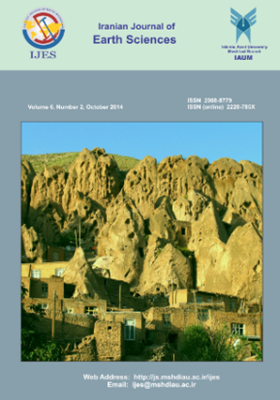-
-
List of Articles
-
Open Access Article
1 - Discrimination of Iron High Potential Zones at the Zaghia Iron Ore Deposit, Bafq, Using Index Overlay GIS Method
Behnam Sadeghi Masoumeh Khalajmasoumi Peyman Afzal Parviz Moarefvand -
Open Access Article
2 - Determination of Travertine Outcrop Types in Tazerj (Northern Hormozgan) using Mineralogical and Geochemical Data
Jamal Tarrah Zahra Abedpour Seyed Mohammad Mirhosseini -
Open Access Article
3 - Classification of Coking Coals in C1 Seam of East-Parvadeh Coal Deposit, Central Iran Using Multifractal Modeling
Peyman Afzal -
Open Access Article
4 - Microbiostratigraphy of the Oligo-Miocene Asmari Formation, Kuh Siah Anticline (Izeh Basin), SW Iran
Iraj Maghfouri Moghaddam Zahra Khanjai -
Open Access Article
5 - Landslide Risk Assessment for Baba Heydar Watershed, Chaharmahal and Bakhtiari Province, Iran
Ebrahim Karimi Sangchini Abdolhossein Arami Hasan Rezaii Moghadam Zainab Khodabakhshi Roya Jafari -
Open Access Article
6 - Petrogenetic Evolution of Plio-Quaternary Mafic Lavas in Nehbandan (East Iran)
Mohammad Reza Ghasempour Javad Mehdipour Ghazi Habib Biabangard Rahim Dabiri -
Open Access Article
7 - Folding Geometry Surveys of Asef Mountain, Northern Shiraz (Southwestern Folded Zagros Belt)
Neda Rezazadeh Ramazan Ramazani Oomali -
Open Access Article
8 - Determination of the Geological Conditions During the Formation of Kaolinite and Bentonite Deposits in NW Alborz Mountains (Pirkoh-Deylaman) of Iran and the Study of Its Practical Properties for Use in the Porcelain Industry
Farzad Asadi Ali Darvishzadeh Ali Montezeri
-
The rights to this website are owned by the Raimag Press Management System.
Copyright © 2021-2026







